You’re doing your morning rounds and all’s right with your summer world when suddenly, your eye catches something the color of a perfectly roasted marshmallow — WHAT-T-T-T-T?
But it’s bigger — much bigger — than a marshmallow, and upon closer inspection, not something you’d want on a S’more.
The glob has swamped some southern coastal roseling ground cover, and a wee jasmine that was just making a come-back after being pruned to the ground after a cold, windy winter had left the shrub in tatters.
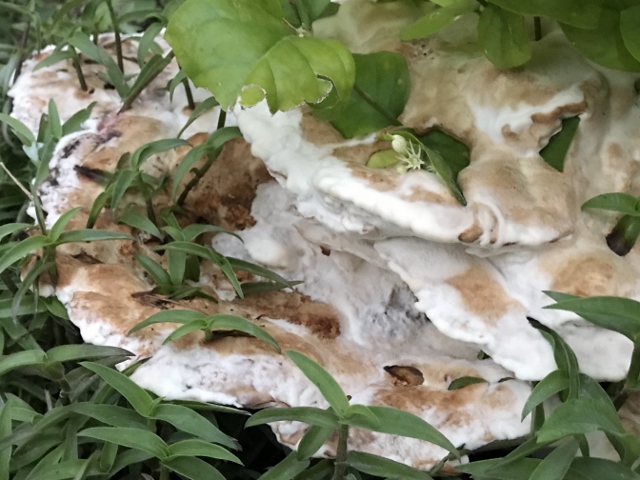
You quickly realize it’s an iNaturalist opportunity, whip out your handy Nature Trackers ruler and Smartphone, take a shot and upload onto the iNaturalist app. Within seconds, choices have popped up: Oak Bracket, Blushing Rosette, Berkeley’s Polypore. If a definitive choice can’t be determined, you select “Fungi including Lichens.” Eventually an expert will identify the upload and you’ll get an e-mail notification.
For something not readily identifiable via the phone app, I like to take several photos and upload them later to http://www.inaturalist.org
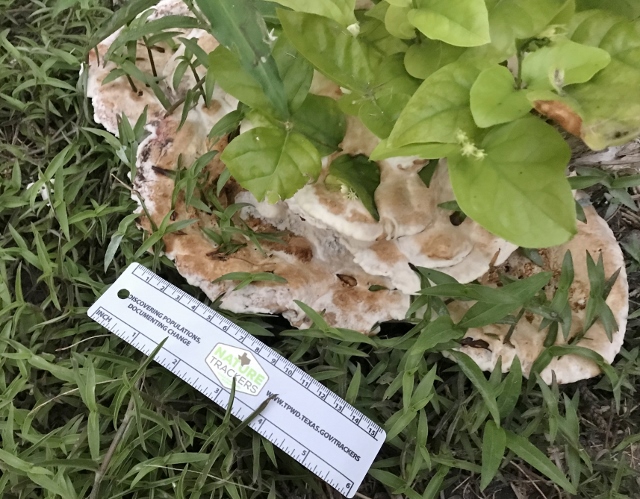
iNaturalist is making a splash in the Valley. Our sister Texas Master Naturalist chapter, South Texas Border Chapter, is inviting Rio Grande Valley Chapter Texas Master Naturalists to come together in a joint activity surrounding iNaturalist promotion.
For the last two years, South Texas Border Chapter has encouraged Valley participation in the iNaturalist annual City Nature Challenge. After this year’s results, STBC held an awards ceremony for the top participants where 18 of the top 20 were from one or the other of the two Valley Texas Master Naturalist chapters.
Discussion after the ceremony elicited that members of both chapters thought a joint project to promote iNaturalist usage throughout the Valley was worthy and warranted.
An interim committee has begun formulating ideas and scheduling volunteers to join local nature center activities.
Tony Henehan, Texas Parks and Wildlife Department, a huge supporter of iNaturalist, is excited about the decision. “This is a great initiative! This is a great program for TMN to spearhead,” he said.
Javier de Leon, advisor to both Valley TMN chapters and Park Superintendent at Texas Parks and Wildlife Department’s Estero Llano Grande State Park, also supports the STBC initiative of a joint project to promote iNaturalist use to Valley residents.
One of the first steps is a call for TMNs from both chapters to join the committee. Committee members will help with ideas, planning and promotion. Committee members also are needed to learn how to use the iNaturalist phone app and computer site and be willing to help educate on how to download the user-friendly app and demonstrate how to use it. Those wanting to help will be trained if they are not already proficient at using the phone app.
Beginning this summer, TMNers will help during previously planned nature center programs and activities and during any booth events either of the chapters schedule. Those living toward the middle to east portion of the Valley may wish to help cover activities in Cameron County; those closer to Hidalgo may prefer working areas from Weslaco to Mission. Volunteers may work any project area they care to. All volunteer hours worked during this iNaturalist initiative are eligible for reporting in the VMS.
Already members will be joining nature center activites for National Moth Week 2019 events. (July 20 to 28) — http://nationalmothweek.org/
Any chapter members who would like to volunteer, when available, to help teach iNaturalist at events, please contact Acting Outreach Chair, Joseph Connors, at josephconnors@gmail.com
Anyone who would like to help in other ways, for instance, ideas or planning, please contact Interim co-chair, 2nd Vice President, STBC of TMN, Elizabeth Perdomo at mateliza@aol.com
The committee is asking any TMNer who would like to explore this project to please consider joining, whether you have a little or a lot of time.
On-going training sessions on how to use iNaturalist can be scheduled at localized areas.
If you’d like to investigate iNaturalist on your own, it’s a user-friendly, free app. The app is available on the App Store. The Website is easy to learn, too: http://www.inaturalist.org
An Internet write up says:
“One of the world’s most popular nature apps, iNaturalist helps you identify the plants and animals around you. Get connected with a community of over 400,000 scientists and naturalists who can help you learn more about nature!
“ . . . you’ll create research quality data for scientists working to better understand and protect nature.
“iNaturalist is a joint initiative by the California Academy of Sciences and the National Geographic Society.”
Wikipedia knows about iNaturalist — https://en.wikipedia.org/wiki/INaturalist — “As of 20 June 2019, iNaturalist users contributed over 25,600,000 observations of plants, animals, and other organisms worldwide, with around 150,000 users active in the previous 30 days.”
Click the photo below for an explanatory blog post about the app from the early days:
If YouTube’s your thing: https://www.youtube.com/channel/UC16Di6Bbo1BeXqp9Ii5uqlg?reload=9
Here’s how iNaturalist helps me: I’ve signed up for a summer Citizen Scientist pollinator event through AgriLife Extension Service. (You can do this, too, if you’d like. It’s not too late.) https://agrilife.az1.qualtrics.com/jfe/form/SV_eyA8ahpNBj5ZJlP
One of the busiest bee plants in my yard is the plantain flowers. I wondered what kind of bees were attracted to the flowers. I took a photo with my phone and uploaded it to iNaturalist. Instantly I had an identification: Western Honey Bee (Apis mellifera).
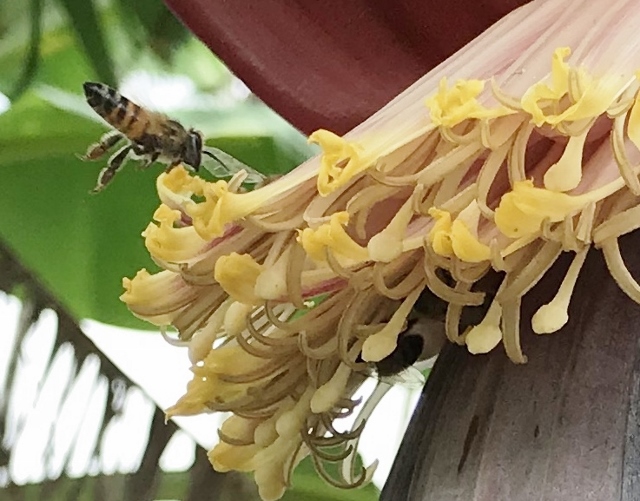
I use iNaturalist when I just want to know what something is that I’ve found in the field.
Another brilliant aspect of iNaturalist is that I can get the identity of a volunteer/errant plant BEFORE I pull it up — just in case it’s something I may want, like this gorgeous (probably) senna upstart that is so beautifully pear-shaped. Sennas are host to the big yellow butterflies!
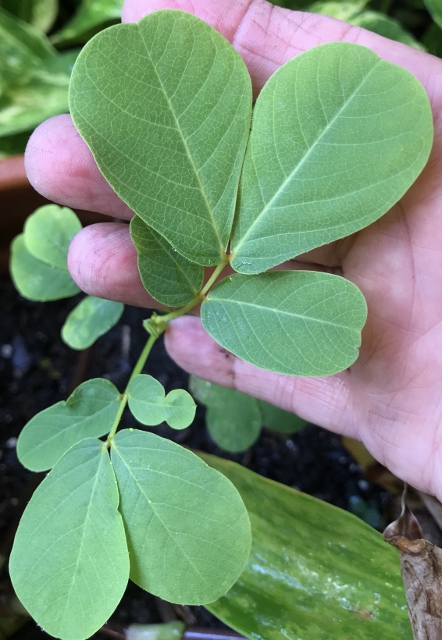
Other times I come across something that was once alive and am curious to know what visits my yard when I’m not looking. iNaturalist quickly IDd this as Virginia Opossum.
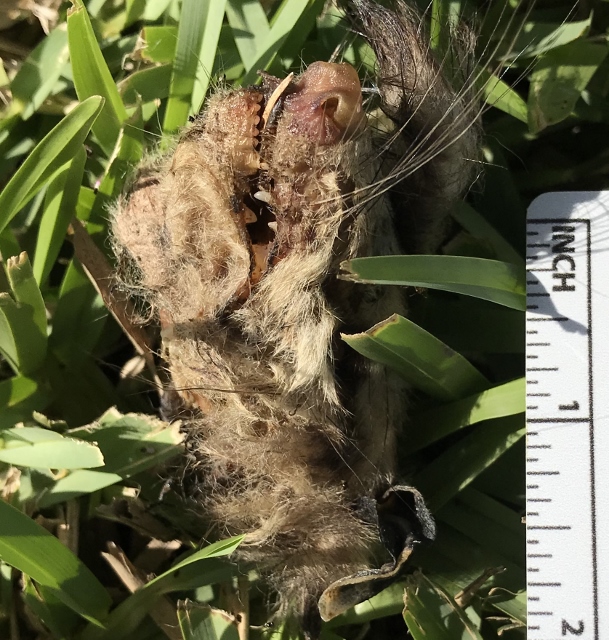
I was glad recently to get confirmation that we have bats flying in our night sky. Unfortunately, that knowledge came from finding a dead bat on the driveway. iNaturalist identified it as a Hairy-tailed bat in the genus, Lasiurus.
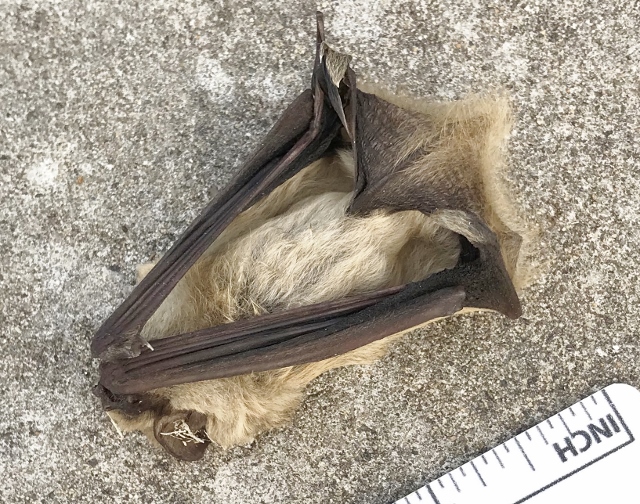
Knowing the name of something allows me to learn more about what’s here and possibly how to care for the land in order to protect the habitat.
If you’re looking for a fun summer (an ongoing) project, check out this joint venture. Contact Joseph or Elizabeth: josephconnors@gmail.com — mateliza@aol.com
Anita, what is that first picture. I have found the marshmallow looking thing in my yard as well.
Would love to know what it is.
I’m awaiting confirmation from iNaturalist. My uploads give options that it may be a Polypore — Berkeley’s or White Cheese Polypore. Another option is that it may be a Giant Puffball (Calvatia gigantea) or perhaps a Blushing Rosette — the rosette is a very close likeness, photographically, but mine has not seeped and crystallized any amber gel-like substance. I broke some of it off. The texture and smell were reminiscent to slicing mushrooms from the grocers — that’s just a description — do NOT taste the one in your garden of course!